Samoyed (dog)
The Samoyed (/ˈsæməjɛd/ SAM-ə-yed or /səˈmɔɪ.ɛd/ sə-MOY-ed;[1] Russian: Самое́дская соба́ка or Самое́д) (also known as the Bjelkier[2]) is a breed of large herding dogs with thick, white, double-layer coats. They are related to the laika, a spitz-type dog.
| Samoyed | ||||||||||||||||||||||||||
|---|---|---|---|---|---|---|---|---|---|---|---|---|---|---|---|---|---|---|---|---|---|---|---|---|---|---|
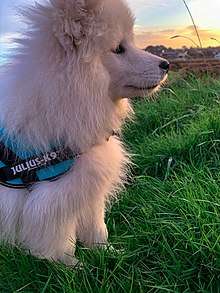 A Samoyed puppy | ||||||||||||||||||||||||||
| Other names | Bjelkier Samoiedskaya Sobaka | |||||||||||||||||||||||||
| Common nicknames | Smiley, Sammy | |||||||||||||||||||||||||
| Origin | Northwest Russia and Western Siberia | |||||||||||||||||||||||||
| Patronage | Nordic Kennel Union | |||||||||||||||||||||||||
| ||||||||||||||||||||||||||
| ||||||||||||||||||||||||||
| Dog (domestic dog) | ||||||||||||||||||||||||||
It takes its name from the Samoyedic peoples of Siberia. These nomadic reindeer herders bred the fluffy white dogs to help with herding.
History
The Samoyed has been identified as a basal breed that predates the emergence of the modern breeds in the 19th Century.[3] It belongs to the spitz or northern dog group, specifically the laikas, a Eurasian dog type used for a variety of purposes, namely hunting, herding, guarding, and sledding. The Samoyed is descended from the Nenets herding laika, a dog that may not only be white, but also a wide variety of colors. Like many breeds, the Samoyed was bred from a small number of founders (in this case, from Siberia).
Samoyeds were originally used for hunting, herding reindeer, and hauling sledges for the Samoyede people in Siberia.[4]
Appearance and characteristics
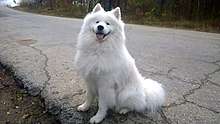
The AKC Standard requires 21–23.5 inches (53–60 cm) at the shoulder for males, and 19–21 inches (48–53 cm) for females. The UK Kennel Club Standard requires 51–56 centimetres (20–22 in) for males, and 46–51 centimetres (18–20 in) for females.
Samoyed eyes are usually black or brown and are almond in shape. Blue or other color eyes can occur but are not allowed in the show ring. It is in the "brown and black section" in its family, the Spitz family.
Samoyed ears are thick and covered with fur, triangular in shape, and erect. They are almost always white but can often have a light to dark brown tint (known as "biscuit"), usually around the tips of the ears.
The Samoyed tail is one of the breed's distinguishing features. Like the Alaskan Malamute, the tail is carried curled over the back; however, unlike the Alaskan Malamute, the Samoyed tail is held actually touching the back. It is not usually held in a tight curl, or held flag-like; it is usually carried lying over the back and to one side. In cold weather, Samoyeds may sleep with their tails over their noses to provide additional warmth. Almost all Samoyeds will allow their tails to fall when they are relaxed and at ease, as when being stroked or while eating, but will return their tails to a curl when more alert.
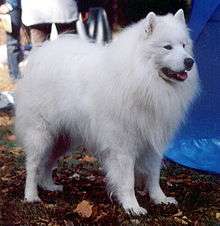
Samoyeds have a dense, double layer coat. The topcoat contains long, coarse, and straight guard hairs, which appear white but have a hint of silver coloring. This top layer keeps the undercoat relatively clean and free of debris. The under layer, or undercoat, consists of a dense, soft, and short fur that keeps the dog warm. The undercoat typically sheds heavily once or twice a year, and this seasonal process is sometimes referred to as "blowing coat". This does not mean the Samoyed will shed only during that time however; fine hairs (versus the dense clumps shed during seasonal shedding) will be shed all year round, and have a tendency to stick to cloth and float in the air. The standard Samoyed may come in a mixture of biscuit and white coloring, although pure white and all biscuit dogs are common. Males typically have larger ruffs than females. While this breed is touted as "hypoallergenic", it does shed a fair amount and needs frequent grooming. While the breed may produce fewer allergens, care should be taken for severe allergies.[5]
Shed Samoyed fur is sometimes used as an alternative to wool in knitting, with a texture similar to angora. The fur is sometimes also used for the creation of artificial flies for fly fishing.
Life expectancy for the breed is about 12–13 years.[6]
Temperament
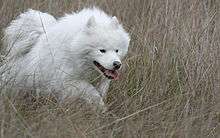
Samoyeds' friendly and affable disposition makes them poor guard dogs; an aggressive Samoyed is rare. The breed is characterized by an alert and happy expression which has earned the nicknames "Sammie smile" and "smiley dog."[7] With their tendency to bark, however, they can be diligent watch dogs, barking whenever something approaches their territory. Samoyeds are excellent companions, especially for small children or even other dogs, and they remain playful into old age. According to the Samoyed Club of America, when Samoyeds become bored, they may become destructive or start to dig.[8] With their sled dog heritage, a Samoyed is not averse to pulling things, and an untrained Samoyed has no problem pulling its owner on a leash rather than walking alongside. Samoyeds were also used to herd reindeer.
Activities
Samoyeds can compete in dog agility trials, carting, obedience, showmanship, flyball, tracking, mushing and herding events. Herding instincts and trainability can be measured at noncompetitive herding tests. Samoyeds exhibiting basic herding instincts can be trained to compete in herding trials.[9]
Health
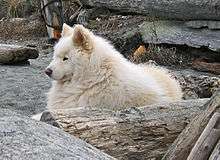
Samoyed hereditary glomerulopathy
The breed can be affected by a genetic disease known as Samoyed hereditary glomerulopathy, a kidney disease. The disease is known to be caused by an X-linked dominant faulty allele and therefore the disease is more severe in male Samoyeds.[10] Also known as hereditary nephritis, it is caused by a nonsense mutation in codon 1027 of the COL4A5 gene on the X chromosome (glycine to stop codon), which is similar to Alport's syndrome in humans.
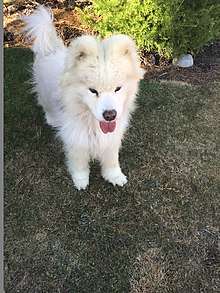
Carrier females do develop mild symptoms after 2–3 months of age, but mostly[11] do not go on to develop kidney failure. The disease is caused by a defect in the structure of the type-IV collagen fibrils of the glomerular basement membrane. As a consequence, the collagen fibrils of the glomerular basement membrane are unable to form cross-links, so the structural integrity is weakened and the membrane is more susceptible to "wear-and-tear" damage. As the structure of the basement membrane begins to degenerate, plasma proteins are lost in the urine and symptoms begin to appear. Affected males appear healthy for the first three months of life, but then symptoms start to appear and worsen as the disease progresses: the dog becomes lethargic and muscle wastage occurs, as a result of proteinuria. From three months of age onwards, a reduced glomerular filtration rate is detected, indicative of progressive kidney failure.

Clinically, proteinuria is found in both sexes from the age of three to four months; in dogs older than this, kidney failure in combination with more or less pronounced hearing loss occurs swiftly and death at the age of 8 to 15 months is expected. In heterozygous females, the disease develops slowly. The disease can be treated to slow down the development by use of cyclosporine A and ACE inhibitors, but not be stopped.[10][12][13][14]
If a carrier female is mated with a healthy stud dog, the female offspring have a 50% chance of being carriers for the disease, and any male offspring have a 50% chance of being affected by the disease. A genetic test is available for this disease.[15]
Other health concerns
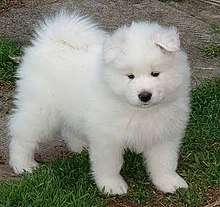
For the Samoyeds in the veterinary literature several breed-specific hereditary diseases are described:
- Diabetes mellitus similar but not identical to human Type I (insulin deficiency): The disease occurs in middle-aged Samoyeds, the mean age at diagnosis is seven years. The cause is a chronic inflammation of the pancreas and / or autoimmune destruction of beta cells of islets of Langerhans. Moreover, in affected dogs autoantibodies were found to insulin. Currently, several genetic markers are discussed as possible causes.[16][17]
- Progressive retinal atrophy (PRA) caused by a frameshift mutation in the RPRG locus of the X chromosome. The disease leads to a slowly progressive loss of vision, which eventually leads to blindness. The first symptoms appear between two and five years of age. The disease corresponds to the X-linked PRA type 3 in humans.[18][19]
- Short legs in conjunction with eye abnormalities: Due to a genetic defect at the COL2A1 locus occurs on disproportionate dwarfism with short limbs in connection with cataracts, malformations of the retina and / or retinal detachment, liquefaction of the vitreous and a persistent hyaloid artery. The malformations of the retina are dominant (i.e. before coming in heterozygous dogs); the other symptoms are recessive, so they only come to expression in homozygous affected dogs. A connection with Opticin is not.[20][21][22]
- Pulmonary stenosis occurs more frequently in Samoyeds in comparison with other breeds. The disease can cause shortness of breath, cardiac arrhythmias and tiring on motion and increases the risk of congestive heart failure.[23]
- Hip dysplasia is also a concern for Samoyeds.[24]
- The breed can also be affected by sebaceous adenitis, an uncommon idiopathic autoimmune skin disease.[25]
References
- Student Dictionary. "Samoyed". World Central. Merriam-Webster Incorporated. Archived from the original on 2 February 2018. Retrieved 2 February 2018.
- "Exploring Genetic Diversity in Samoyeds With a Genome-Wide DNA Analysis". Retrieved 4 December 2014.
- Larson, G (2012). "Rethinking dog domestication by integrating genetics, archeology, and biogeography". Proc. Natl. Acad. Sci. U.S.A. 109 (23): 8878–83. Bibcode:2012PNAS..109.8878L. doi:10.1073/pnas.1203005109. PMC 3384140. PMID 22615366.
- "The Samoyed: Breed Origin and History". samoyedclubofamerica.org.
- Bakalar, Nicholas (11 July 2011). "The Myth of the Allergy-Free Dog". The New York Times. Retrieved 18 July 2015.
- "Individual Breed Results for Purebred Dog Health Survey". TheKennelClub.org.uk.
- "AKC Meet the Breeds: Samoyed". American Kennel Club. Archived from the original on 11 January 2013. Retrieved 8 October 2011.
- "Bad Habits and Training".
- Hartnagle-Taylor, Jeanne Joy; Taylor, Ty (2010). Stockdog Savvy. Alpine Publications. ISBN 978-1-57779-106-5.
- Jansen, B; Tryphonas, L; Wong, J; Thorner, P; Maxie, MG; Valli, VE; Baumal, R; Basrur, PK (1986). "Mode of inheritance of Samoyed hereditary glomerulopathy: an animal model for hereditary nephritis in humans". The Journal of Laboratory and Clinical Medicine. 107 (6): 551–5. PMID 3711721.
- Rawdon, TG (2001). "Juvenile nephropathy in a Samoyed bitch". The Journal of Small Animal Practice. 42 (5): 235–8. doi:10.1111/j.1748-5827.2001.tb02027.x. PMID 11380016.
- Zheng, K; Thorner, PS; Marrano, P; Baumal, R; McInnes, RR (1994). "Canine X chromosome-linked hereditary nephritis: a genetic model for human X-linked hereditary nephritis resulting from a single base mutation in the gene encoding the alpha 5 chain of collagen type IV". Proceedings of the National Academy of Sciences of the United States of America. 91 (9): 3989–93. doi:10.1073/pnas.91.9.3989. PMC 43708. PMID 8171024.
- Grodecki, K; Gains, M; Baumal, R; Osmond, D; Cotter, B; Valli, V; Jacobs, R (1997). "Treatment of X-linked hereditary nephritis in samoyed dogs with angiotensin converting enzyme (ACE) inhibitor". Journal of Comparative Pathology. 117 (3): 209–225. doi:10.1016/S0021-9975(97)80016-3. PMID 9447482.
- Chen, D.; Jefferson, B; Harvey, SJ; Zheng, K; Gartley, CJ; Jacobs, RM; Thorner, PS (2003). "Cyclosporine A Slows the Progressive Renal Disease of Alport Syndrome (X-Linked Hereditary Nephritis): Results from a Canine Model". Journal of the American Society of Nephrology. 14 (3): 690–8. doi:10.1097/01.ASN.0000046964.15831.16. PMID 12595505.
- "Samoyed Hereditary Glomerulopathy". vetgen.com. Veterinary Genetic Services. Retrieved 3 February 2013.
- Kimmel, SE; Ward, CR; Henthorn, PS; Hess, RS (2002). "Familial insulin-dependent diabetes mellitus in Samoyed dogs". Journal of the American Animal Hospital Association. 38 (3): 235–8. doi:10.5326/0380235. PMID 12022409.
- Short, A. D.; Catchpole, B.; Kennedy, L. J.; Barnes, A.; Fretwell, N.; Jones, C.; Thomson, W.; Ollier, W. E.R. (2007). "Analysis of Candidate Susceptibility Genes in Canine Diabetes". Journal of Heredity. 98 (5): 518–525. doi:10.1093/jhered/esm048. PMID 17611256.
- Dice, P. F. 2nd (1980). "Progressive retinal atrophy in the Samoyed". Modern Veterinary Practice. 61 (1): 59–60. PMID 7366567.
- Zangerl, B.; Johnson, J. L.; Acland, G. M.; Aguirre, G. D. (2007). "Independent Origin and Restricted Distribution of RPGR Deletions Causing XLPRA". Journal of Heredity. 98 (5): 526–530. doi:10.1093/jhered/esm060. PMID 17646274.
- Meyers, VN; Jezyk, PF; Aguirre, GD; Patterson, DF (1983). "Short-limbed dwarfism and ocular defects in the Samoyed dog". Journal of the American Veterinary Medical Association. 183 (9): 975–79. PMID 12002589.
- Acland, Gregory M. (1991). "Retinal dysplasia in the Samoyed dog is the heterozygous phenotype of the gene (drds) for short limbed dwarfism and ocular defects". Transactions of the American College of Veterinary Ophthalmology. 22: 44.
- Pellegrini, B; Acland, GM; Ray, J (2002). "Cloning and characterization of opticin cDNA: evaluation as a candidate for canine oculo-skeletal dysplasia". Gene. 282 (1–2): 121–131. doi:10.1016/S0378-1119(01)00842-3. PMID 11814684.
- McCaw, D; Aronson, E (1984). "Congenital cardiac disease in dogs". Modern Veterinary Practice. 65 (7): 509–12. PMID 6749116.
- Martin, SW; Kirby, K; Pennock, PW (1980). "Canine hip dysplasia: breed effects". The Canadian Veterinary Journal. 21 (11): 293–6. PMC 1789813. PMID 7459792.
- Craig, Mark (2006). "Clinical refresher: Canine sebaceous adenitis". Companion Animal. 11 (5): 62–8. doi:10.1111/j.2044-3862.2006.tb00066.x.
Further reading
- Bernard, MA; Valli, VE (1977). "Familial renal disease in Samoyed dogs". The Canadian Veterinary Journal. 18 (7): 181–9. PMC 1697612. PMID 884645.
- Meyers, VN; Jezyk, PF; Aguirre, GD; Patterson, DF (1983). "Short-limbed dwarfism and ocular defects in the Samoyed dog". Journal of the American Veterinary Medical Association. 183 (9): 975–9. PMID 12002589.
- Kimmel, SE; Ward, CR; Henthorn, PS; Hess, RS (2002). "Familial insulin-dependent diabetes mellitus in Samoyed dogs". Journal of the American Animal Hospital Association. 38 (3): 235–8. doi:10.5326/0380235. PMID 12022409.